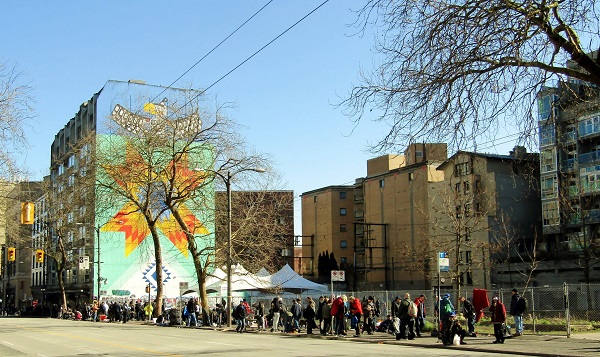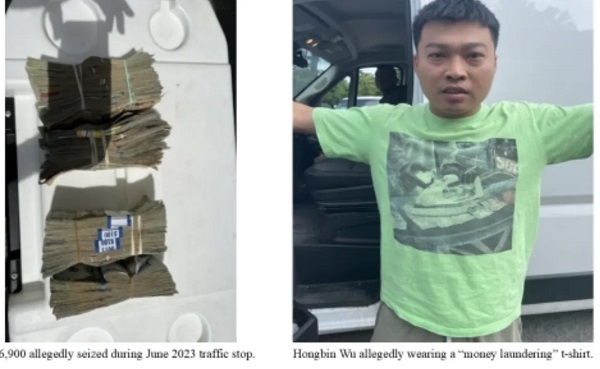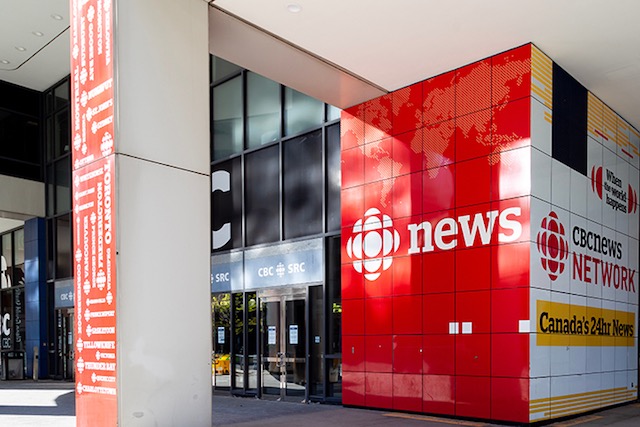Addictions
B.C. poll reveals clash between Indigenous views and drug policy


By Alexandra Keeler
A supermajority of First Nations respondents disagree that criminalizing drug use is racist, challenging public health advocates’ assumptions
A new report shows a majority of British Columbians — and a plurality of all ethnic communities surveyed — disagree with the contention that drug criminalization policies are racist.
The findings challenge assertions made by prominent B.C. policymakers, who have advocated for drug decriminalization and harm-reduction initiatives on the grounds of anti-racism and reconciliation.
The report, published by the policy nonprofit Centre for Responsible Drug Policy and think tank Macdonald-Laurier Institute, draws from a poll of 6,300 B.C. adults that was commissioned by the centre and conducted by Mainstreet Research.
“Chinese and Indigenous leaders keep telling me that their communities are very anti-drug, but public health officials and harm-reduction activists keep saying that legalization is integral to anti-racism and reconciliation,” said Adam Zivo, a journalist and founder of the centre.
“Now we have data to show which side is more accurate.”
When asked whether criminalizing drug use is racist, just 22 per cent of all respondents agreed, while 60 per cent disagreed. Notably, 79 percent of the respondents identified as white.
Disagreement was strongest among First Nations respondents, with just nine per cent of the 172 Indigenous respondents agreeing that criminalization is racist and 67 per cent disagreeing.
Agreement was stronger among Asian communities, with East Asian and South Asian respondents being most likely to say criminalization policies are racist.
In the East Asian cohort, 42 per cent said they disagreed that criminalizing drug use is racist, while 36 per cent strongly agreed. Similarly, 46 per cent of South Asian respondents disagreed and 32 per cent agreed.
Self-determination
The poll challenges views articulated by some prominent B.C. policymakers and public health groups.
In July, B.C.’s provincial health officer, Dr. Bonnie Henry, released a report asserting that drug policies prohibiting the use of hard drugs are rooted in racism and colonialism.
“Prohibitionist drug policies are deeply rooted in colonialism, reflecting and perpetuating systemic racism that disproportionately impacts Indigenous peoples,” Henry’s report says.
“These policies were designed to control marginalized populations and have led to over-incarceration, intergenerational trauma, and significant health disparities within these communities.”
Henry’s report contends that decriminalization policies — such as those implemented by B.C. as part of a three-year trial project that began January 2023 — can help to rectify these injustices by prioritizing health and safety over law enforcement.
Henry’s report was released mere months after B.C. rolled back some of its decriminalization measures in response to growing public concerns over decriminalization’s effects on community safety and order. Henry’s report, which is published by the BC Ministry of Health, urges the province to move in the opposite direction.
“This report’s recommendation is to continue to refine and expand prescribed alternatives to unregulated drugs, and critically, to explore implementation of models that do not require prescription,” Henry writes, referring to harm-reduction initiatives such as safer supply that dispense prescription opioids to drug users.
The report presents decriminalization as a move supported by Indigenous communities, citing the Declaration on the Rights of Indigenous Peoples Act Action Plan. Action 4.12 aims to “address the disproportionate impacts of the overdose public health emergency on Indigenous Peoples by: applying to the Government of Canada to decriminalize simple possession of small amounts of illicit drugs for personal use.”
The Canadian Drug Policy Coalition, a policy advocacy group based out of Simon Fraser University, has similarly contended that drug criminalization is racist.
The coalition’s website says, “the demand by Black communities to decriminalize drugs and to immediately expunge records are a vital necessity for minimizing the racially disproportionate harms of drug criminalization, part of a broader struggle to end the war on Black communities.”
And in December 2023, the Harm Reduction Nurses Association, a national organization that advances harm-reduction nursing, obtained an injunction to prevent the B.C. government from imposing restrictions on public drug consumption.
The association alleged the government’s actions “would put people at greater risk of fatal overdose, make healthcare outreach more challenging, and drive racial discrimination, particularly against Indigenous people.”
Subscribe for free to get BTN’s latest news and analysis, or donate to our journalism fund.
Minority polling challenges
Some Indigenous groups have expressed reservations about blanket decriminalization policies in other contexts.
In January 2024, the First Nations Health Authority, an agency that manages health services for Indigenous communities in B.C., issued a statement acknowledging decriminalization may not be the best approach for all communities.
“FNHA acknowledges and supports the self-determination of each First Nations community when considering implementing this exemption,” the statement reads, referring to the three-year exemption B.C. obtained from federal laws prohibiting the use of hard drugs.
First Nations Health Authority has emphasized the need for culturally informed approaches that prioritize community health and safety and advocated for nuanced strategies tailored to each community’s specific needs.
The Mainstreet Research poll reveals challenges in accurately representing the views of B.C.’s smaller ethnic communities.
While non-white Canadians make up 40 per cent of B.C.’s population, they accounted for only 16 per cent of the poll’s 6,300 respondents.
Responses by Black, Middle Eastern and Southeast Asian respondents were excluded from the current analysis because sample sizes were too small, numbering below 100. The English-only and automated telephone polling format may also increase uncertainty.
As the poll focused primarily on B.C. and broad drug policy questions, its findings underscore the need for a deeper understanding of community beliefs to inform drug policies.
The Centre for Responsible Drug Policy is releasing the polling data and its report on a “preliminary” basis so it can inform drug policy discussions ahead of provincial elections, which are taking place this October in B.C., Saskatchewan and New Brunswick.
But Mainstreet Research is continuing to gather data, aiming for a final survey size of more than 12,000 respondents. Once completed, the survey will be one of the largest polls on harm reduction ever conducted in Canada.
“The final report, set to be released later this year, will include larger samples from B.C.’s diverse ethnic communities, providing further clarity on their beliefs,” Zivo said.
This article was produced through the Breaking Needles Fellowship Program, which provided a grant to Canadian Affairs, a digital media outlet, to fund journalism exploring addiction and crime in Canada. Articles produced through the Fellowship are co-published by Break The Needle and Canadian Affairs.
Subscribe to Break The Needle. Our content is always free – but if you want to help us commission more high-quality journalism, consider getting a voluntary paid subscription.
Addictions
More young men want to restrict pornography: survey

From LifeSiteNews
Nearly 64% of American men now believe online pornography should be more difficult to access, with even higher numbers of women saying the same thing.
A new survey has shown that an increasing number of young men want more restrictions on online pornography.
According to a survey by the American Enterprise Institute’s Survey Center on American Life, nearly 7 in 10 (69 percent) of Americans support the idea of making online pornography less accessible. In 2013, 65 percent expressed support for policies restricting internet pornography.
The most substantial increase in the support for restrictive measures on pornography could be observed in young men (age 18-24). In 2013, about half of young men favored restrictions, while 40 percent actively opposed such policies. In 2025, 64 percent of men believe accessing online pornography should be made more difficult.
The largest support for restriction on internet pornography overall could be measured among older men (65+), where 73 percent favored restrictions. An even larger percentage of women in each age group supported making online pornography less accessible. Seventy-two percent of young women (age 18-24) favored restriction, while 87 percent of women 55 years or older expressed support for less accessibility of internet pornography.
Viewing pornography is highly addictive and can lead to serious health problems. Studies have shown that children often have their first encounter with pornography at around 12 years old, with boys having a lower average age of about 10-11, and some encountering online pornography as young as 8. Studies have also shown that viewing pornography regularly rewires humans brains and that children, adolescents, and younger men are especially at risk for becoming addicted to online pornography.
According to Gary Wilson’s landmark book on the matter, “Your Brain on Porn,” pornography addiction frequently leads to problems like destruction of genuine intimate relationships, difficulty forming and maintaining real bonds in relationship, depression, social anxiety, as well as reduction of gray matter, leading to desensitization and diminished pleasure from everyday activities among many others.
Addictions
Can addiction be predicted—and prevented?

These four personality traits are predictive of addiction. A new program is using this knowledge to prevent addiction from ever developing
In classrooms across Canada, addiction prevention is getting personal.
Instead of warning students about the dangers of drugs, a program called PreVenture teaches students about themselves — and it’s working.
Developed by Canadian clinical psychologist Patricia Conrod, PreVenture helps young people recognize how traits like risk-taking or negative thinking shape their reactions to stress.
“When you intervene around these traits and help people learn new cognitive behavioural strategies to manage these traits, you are able to reduce their substance use,” said Conrod, who is also a professor at the Université de Montréal.
By tailoring addiction prevention strategies to individual personality profiles, the program is changing how we think about addiction — from something we react to, to something we might stop before it starts.
And now, scientists say the potential for early intervention is going even deeper — down to our genes.
Personality and addiction
PreVenture is a personality-targeted prevention program that helps young people understand and manage traits linked to a higher propensity for future substance use.
The program focuses on four core traits — anxiety sensitivity, sensation seeking, impulsivity and hopelessness — that shape how individuals experience the world and respond to stress, social situations and emotional challenges.
“They don’t only predict who’s at risk,” said Conrod in an interview with Canadian Affairs. “They predict what you’re at risk for with quite a lot of specificity.”
Anxiety sensitivity shows up in people who feel overwhelmed by physical symptoms like a racing heart or dizziness. People with this trait may ultimately turn to alcohol, benzodiazepines such as Xanax, or opioids to calm their bodies.
Sensation seeking is characterized by a desire for excitement and novel experiences. This trait is associated with a higher likelihood of being drawn to substances like cannabis, MDMA, psilocybin or other hallucinogens.
“[Cannabis] alters their perceptual experiences, and so makes things feel more novel,” said Conrod.
Sensation seeking is also associated with binge drinking or use of stimulants such as cocaine.
The trait of impulsivity involves difficulty controlling urges and delaying gratification. This trait is associated with a higher likelihood of engaging in risky behaviours and an increased risk of addiction to a broad range of substances.
“Young people with attentional problems and a core difficulty with response inhibition have a hard time putting a stop on a behaviour once they’ve initiated it,” said Conrod.
Finally, the trait of hopelessness is tied to a pessimistic, self-critical mindset. People with this trait often expect rejection or assume others are hostile, so they may use alcohol or opioids to dull emotional pain.
“We call it negative attributional style,” said Conrod. “They have come to believe that the world is against them, and they need to protect themselves.”
These traits also cluster into two broader categories — internalizing and externalizing.
Anxiety sensitivity and hopelessness direct distress inward, while sensation seeking and impulsivity are characterized by outward disinhibition.
“These traits change your perception,” said Conrod. “You see the world differently through these traits.”
Conrod also notes that these traits appear across cultures, making targeted addiction prevention broadly applicable.
Personality-based prevention
Unlike most one-size-fits-all drug prevention programs, PreVenture tailors its prevention strategies for each individual trait category to reduce substance use risk.
The program uses a brief personality assessment tool to identify students’ dominant traits. It then delivers cognitive-behavioural strategies to help users manage stress, emotions and risky behaviours associated with them.

Recreation of the personality assessment tool based on the substance use risk profile scale — a scale measuring traits linked to reinforcement-specific substance use profiles. | Alexandra Keeler
Students learn to recognize how their dominant trait influences their thoughts and reactions — and how to shift those patterns in healthier directions.
“We’re trying to raise awareness to young people about how these traits are influencing their automatic thinking,” said Conrod. “You’re having them be a little more critical of their thoughts.”
Hopelessness is addressed by teaching strategies to challenge depressive thoughts; those high in sensation seeking explore safer ways to satisfy their need for stimulation; anxiety sensitivity is managed through calming techniques; and impulsivity is reduced by practicing pausing before acting.
Crucially, the program emphasizes the strengths of each trait as well.
“We try to present [traits] in a more positive way, not just a negative way,” said Sherry Stewart, a clinical psychologist at Dalhousie University who collaborates with Conrod.
“Your personality gets you into trouble — certainly, we discuss that — but also, what are the strengths of your personality?”
While a main goal of the program is preventing substance use disorders, the program barely discusses substances.
“You don’t really have to talk about substances very much,” said Conrod. “You talk more about how you’re managing the trait, and it has this direct impact on someone’s motivation to use, as well as how severely they experience mental health symptoms.”
The workshops make it clear, however, that while substances may offer temporary relief, they often worsen the very symptoms participants are trying to manage.
The genetic angle
Catherine Brownstein, a Harvard Medical School professor and geneticist at Boston Children’s Hospital, says genetic factors also help explain why some people are more vulnerable to addiction.
“A lot of personality is genetic,” she said in an interview with Canadian Affairs.
Her research has identified 47 locations in human DNA that affect brain development and shape personality traits.
While substance use risk cannot yet be detected genetically, certain gene variants — like SHANK3, NRXN1 and CRY1 — are linked to psychiatric disorders that often co-occur with substance use, including ADHD and schizophrenia.
Brownstein also says genetic variations influence pain perception.
Some variants increase pain sensitivity, while others eliminate it altogether. One such gene, SCN9A, may make individuals more likely to seek opioids for relief.
“If you’re in pain all the time, you want it to stop, and opioids are effective,” said Brownstein.
While we cannot yet predict addiction risk from genetics alone, Brownstein says she thinks genetic screening combined with psychological profiling could one day personalize prevention even further.
Expansion and challenges
Conrod’s personality-targeted intervention program, PreVenture, has proven highly effective.
A five-year study published in January found that students who participated in PreVenture workshops were 23 to 80 per cent less likely to develop substance use disorders by Grade 11.
Stewart says that the concept of PreVenture began with adults with substance use disorders, but research suggests earlier intervention can alter life trajectories. That insight has driven PreVenture’s expansion to younger age groups.
Conrod’s team delivers PreVenture to middle and high school students, UniVenture to university students and OpiVenture to adults in treatment for opioid dependence.
PreVenture has been implemented in schools across the U.S. and Canada, including in B.C., Ontario, Quebec, Nova Scotia and Newfoundland and Labrador. Five Canadian universities are participating in the UniVenture study.
However, currently, Canada’s flagship youth prevention strategy is based on the Icelandic Prevention Model — a 1990s framework that aims to reduce youth substance use by focusing on environmental factors such as family, school and peer influence.
While the Icelandic Prevention Model has shown success in Iceland, it has serious limitations. It lacks a mental health component, does not specifically address opioid use and has demonstrated mixed results by gender.
Despite strong evidence for personality-targeted prevention, programs like PreVenture remain underused.
Conrod says education systems often default to less effective, generic methods like one-off guest speakers. She also cites staffing shortages and burnout in schools, along with insufficient mental health services, as major barriers to implementing a new program.
Still, momentum is building.
B.C. has aligned their prevention services with the PreVenture model. And organizations such as the youth wellness networks Foundry B.C. and Youth Wellness Hubs Ontario are offering the program and expanding its reach.
Conrod believes the power of the program lies in helping young people feel seen and understood.
“It’s really important that a young person is provided with the space and focus to recognize what’s unique about [their] particular trait,” she said.
“Recognize that there are other people in the world that also think this way [and tell them] you’re not going crazy.”
This article was produced through the Breaking Needles Fellowship Program, which provided a grant to Canadian Affairs, a digital media outlet, to fund journalism exploring addiction and crime in Canada. Articles produced through the Fellowship are co-published by Break The Needle and Canadian Affairs.
-

 Crime2 days ago
Crime2 days agoSweeping Boston Indictment Points to Vast Chinese Narco-Smuggling and Illegal Alien Labor Plot via Mexican Border
-

 Business17 hours ago
Business17 hours agoMost Canadians say retaliatory tariffs on American goods contribute to raising the price of essential goods at home
-

 National1 day ago
National1 day agoWomen and girls beauty pageant urges dismissal of transgender human rights complaint
-

 Alberta17 hours ago
Alberta17 hours agoCross-Canada NGL corridor will stretch from B.C. to Ontario
-

 International2 days ago
International2 days agoSupport for the Ukraine war continues because no one elected is actually in charge.
-

 Business2 days ago
Business2 days agoTrump slaps Brazil with tariffs over social media censorship
-

 Business2 days ago
Business2 days agoCBC six-figure salaries soar
-

 Business18 hours ago
Business18 hours agoB.C. premier wants a private pipeline—here’s how you make that happen




